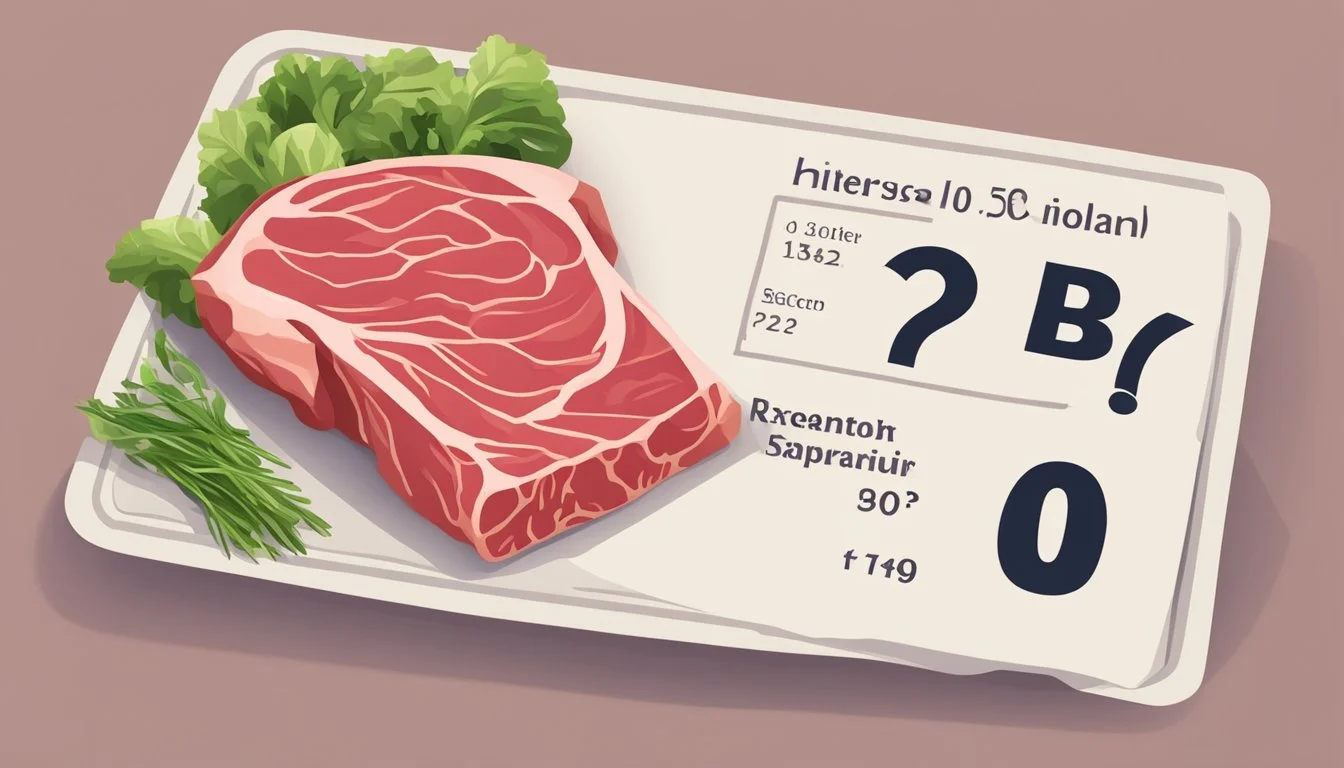Is Red Meat a Health Risk?
Unpacking Nutritional Debates
Red meat (What wine goes well with red meat?), a staple in many diets around the world, is a source of key nutrients such as protein, vitamin B12, and zinc. However, its consumption has also been a topic of health debates for decades. Scientific studies have consistently shown associations between high intakes of red and processed meats and increased health risks. These risks include heart disease, stroke, certain types of cancer, and diabetes. The saturated fats found in red meats are known to raise LDL cholesterol, often referred to as "bad" cholesterol, which contributes to cardiovascular disease.
The controversy surrounding red meat is fueled by varying study results and methodologies. While some observational studies suggest a correlation between red meat consumption and negative health outcomes, they often face limitations such as confounding factors that prevent a definitive conclusion about causation. Furthermore, recent research has started to question the strength of these associations, highlighting the need for more nuanced discussions about meat intake and health.
Health experts often recommend moderation when consuming red meat. Suggested limits are typically around 12 to 18 ounces of cooked red meat per week, with a cautionary note on the intake of processed meats. These recommendations are particularly important for individuals with existing health conditions such as high cholesterol, high blood pressure, or heart failure. It is important for consumers to make informed choices regarding their diet, considering both the nutritional benefits and the potential health risks associated with red meat consumption.
Nutritional Profile of Red Meat
Red meat is often recognized for its high-quality protein and richness in various essential nutrients. It is an important dietary component for its micronutrient content, but its fat composition also warrants careful consideration.
Iron and Vitamin Content
Red meat is an excellent source of heme iron, which is more readily absorbed by the body than the non-heme iron found in plant foods. This is particularly important for populations at risk of anemia. Moreover, red meat is rich in vitamin B12, a crucial nutrient for nerve function and blood formation that is not naturally found in plant-based foods. It also contains significant amounts of zinc, which is vital for immune function and metabolism. The presence of myoglobin contributes to the iron content, further distinguishing red meat as an important iron source.
Important micronutrients found in red meat:
Iron (specifically heme iron)
Vitamin B12
Zinc
Other minerals and vitamins in smaller quantities
Saturated Fat and Cholesterol Concerns
Red meat is associated with saturated fat and cholesterol, two factors closely monitored in relation to cardiovascular health. The fat composition varies with the cut of meat and its preparation. For instance, 113 grams (4 ounces) of 80% lean ground beef contains approximately:
Calories: 287
Total fat: 23g
Saturated fat: 9g
Cholesterol: 77mg
Saturated fats can increase levels of LDL cholesterol ("bad" cholesterol) in the blood, which is a known risk factor for heart disease. Therefore, nutrition guidelines typically recommend moderating the intake of red meat, particularly focusing on leaner cuts and considering cooking methods that reduce fat content.
Red Meat and Chronic Diseases
Consumption of red meat has been scrutinized for potential links to a variety of chronic diseases. Research data indicates a correlation with increased risk of heart disease, type 2 diabetes, and certain cancers.
Association with Heart Disease
Research suggests that high intake of red meat, particularly those high in saturated fat and cholesterol, can contribute to cardiovascular disease. This is partly due to the potential for increased blood pressure and arterial plaque buildup, leading to coronary heart disease. The American Heart Association advises moderation in red meat consumption to mitigate health risks.
Red Meat's Role in Type 2 Diabetes
Studies point towards a connection between red meat consumption and the prevalence of type 2 diabetes. Components within red meat, such as high levels of saturated fats, may influence obesity—a major risk factor in the development of diabetes. The relationship is complex, yet the evidence raises concerns about red meat being a contributing factor in the diabetes epidemic.
Cancer Risks Associated with Red Meat
The International Agency for Research on Cancer (IARC), part of the World Health Organization, classifies processed red meat as a Group 1 carcinogen, indicating sufficient evidence that its consumption can increase the risk of colorectal cancer. The World Cancer Research Fund also recommends limiting red meat intake due to potential connections to breast cancer and other cancer types. The risk is believed to be linked to certain compounds formed during processing or cooking of red meat at high temperatures.
Processed Meat Versus Unprocessed
When evaluating red meat and health risks, it is crucial to distinguish between processed meats and their unprocessed counterparts due to the varying levels of associated health risks.
Differences in Health Impact
Processed meats like bacon, sausage, hot dogs, and salami differ from unprocessed meats, which include raw cuts of beef, pork, and lamb. The main difference lies in the manufacturing process. Processed meats have been altered through methods such as salting, curing, or smoking, often to enhance flavor or preserve the meats. Unprocessed meats are sold raw and generally without any preservatives like nitrates or nitrites.
Processed Meat and Increased Health Risks
A variety of health risks are more readily associated with processed meats. Studies indicate that consuming processed meats may lead to an increased risk of serious health conditions, including colorectal cancer and cardiovascular disease. For example, when assessing the relationship with cancer, every 50 grams of processed meat consumed per day may heighten the risk of colorectal cancer by an estimated 18 percent.
Assessing the Consumption of Processed Versus Whole Cuts
In terms of consumption, it's suggested that physical health can be influenced by the proportion of processed to unprocessed meats in one's diet. While lean cuts of unprocessed red meat like beef, as well as poultry and white meat, (What wine goes well with white meat?) may be included as part of a balanced diet, processed red meats should be consumed with caution due to the addition of preservatives and the higher health risks they pose, including a higher likelihood of stroke and colorectal cancer.
Comparative Dietary Choices
When assessing the impact of red meat on health, it is essential to consider the variety of dietary choices available that offer different nutritional profiles. The key lies in understanding red meat alternatives, the impact of diverse protein sources, and the role of plant proteins and other options in a balanced diet.
Red Meat Alternatives
Red meat, such as beef, pork, and lamb, can be substituted with options like poultry, fish, and seafood. These alternatives provide essential proteins with a varying composition of fats. For instance:
Fish: Rich in omega-3 fatty acids, fish is linked to a lower risk of heart disease.
Poultry: Typically lower in saturated fat compared to red meat, making it a heart-healthier choice.
Impact of Diverse Protein Sources
Integrating a mix of protein sources is beneficial for overall health. Legumes, nuts, and dairy are excellent protein sources that also offer other health benefits:
Legumes (beans, lentils): Provide protein and fiber and are associated with lower cholesterol levels.
Nuts: Contain healthy monounsaturated fats, protein, and fiber.
Dairy: A source of calcium, vitamin D, and protein, dairy can be part of a nutritious diet when consumed in moderation.
Incorporating Plant Proteins and Other Options
Beyond animal sources, plant-based proteins have gained popularity due to their associated health benefits and lower environmental impact:
Soy products (tofu, tempeh): High-quality protein containing all essential amino acids.
Whole grains and vegetables: Provide additional proteins often with high fiber content, which is important for digestive health.
Each dietary choice offers a unique nutrient profile supporting the rationale behind a diversified diet for health optimization and disease prevention.
Role of Cooking and Preparation Methods
The way red meat is cooked and prepared can significantly impact its health implications. Cooking methods that use high temperatures, such as grilling and frying, as well as the choice of meat, including grass-fed, organic, or lean cuts, can affect the nutritional content and potential risks associated with red meat consumption.
Cooking Techniques and Health Implications
Certain cooking techniques, specifically those that involve high temperatures, may increase health risks. Grilling and frying, for instance, can lead to the formation of potentially harmful compounds, such as heterocyclic amines (HCAs) and polycyclic aromatic hydrocarbons (PAHs), which are associated with an increased risk of cancer. Moreover, the high temperature used in these cooking methods can alter the fat profile of the meat, potentially increasing its caloric content.
Grilling: Can create charred areas where HCAs and PAHs are more likely to form.
Frying: May add additional calories and fat, depending on the type and amount of oil used.
On the contrary, methods like baking, stewing, and braising tend to cook meat at lower temperatures, reducing the formation of these harmful compounds. It is advisable to cook meat thoroughly to eliminate harmful bacteria while avoiding overcooking to minimize health risks.
Choosing Healthier Red Meat Options
Selecting healthier red meat options can aid in reducing health risks. Grass-fed beef typically contains more beneficial nutrients such as omega-3 fatty acids and antioxidants when compared to grain-fed counterparts. It's often recommended to choose lean cuts of meat to minimize sodium and saturated fat intake.
Grass-Fed: May have a favorable nutritional profile with higher levels of certain nutrients.
Organic: Less likely to contain antibiotics and hormones.
Lean Cuts: Lower in fat and calories, and often in sodium if unsalted seasonings are used.
Including a variety of proteins in the diet, both plant and animal sources, while paying attention to preparation methods and opting for healthier red meat choices, can be part of a balanced and healthful diet.
Evidence and Research Findings
The relationship between red meat consumption and health risks has been a topic of extensive research. Scientists have employed different study designs, each providing varying levels of evidence, to understand how red meat affects nutrition and health.
Observational Studies Versus Clinical Trials
Observational studies, which include large cohorts followed over time, suggest a linkage between red meat intake and a heightened risk of health issues such as type 2 diabetes, cardiovascular disease, and certain cancers. For example, the Global Burden of Diseases study by the Institute for Health Metrics and Evaluation at the University of Washington estimated that a significant number of deaths and disability-adjusted life years were attributable to unprocessed red meat consumption.
On the other hand, randomized controlled trials (RCTs), which are less susceptible to confounding variables, may not always align with the results from observational studies. This discrepancy often raises questions about causality versus correlation. RCTs are considered the gold standard in clinical research because they are designed to establish a clear cause-and-effect relationship by controlling variables that can affect the outcome of the study.
Analyzing Meta-Analyses and Effect Sizes
Meta-analyses synthesize multiple studies to ascertain the overall effect size and strength of evidence regarding red meat's impact on health. They aim to derive a more precise estimation of the effect by combining multiple study results. Scientists utilize both observational studies and RCTs for their meta-analyses, which can help overcome the limitations of individual studies that may have small sample sizes or varying methodologies.
Effect sizes, quantified in these meta-analyses, convey the magnitude of the relationship between red meat consumption and health outcomes. They are crucial for interpreting the practical significance of research findings. Meta-analyses may differ in their conclusions based on the types of studies included, the methodologies employed, and the health outcomes measured. It is essential to consider not just the existence of an association but also the size of the effect when evaluating nutritional recommendations such as the number of servings per week of red meat.
Public Health Recommendations and Guidelines
In considering the impact of red meat on health, several leading health organizations have established guidelines and classifications to assist the public. These guidelines are founded on extensive research examining the connection between red meat consumption and the risk of developing chronic diseases such as heart disease and certain cancers.
American Heart Association Guidelines
The American Heart Association (AHA) advocates for a dietary pattern that emphasizes intake of fruits, vegetables, whole grains, and lean proteins, and it includes specific recommendations for red meat. They suggest opting for lean cuts and aiming for less than two servings per week to minimize the risk of heart disease. The AHA's approach emphasizes the importance of balance and nutrient density in one's diet.
World Health Organization Classifications
The World Health Organization (WHO), through its International Agency for Research on Cancer (IARC), classifies processed meat as a Group 1 carcinogen, indicating that there is sufficient evidence that it causes cancer—specifically colorectal cancer. Additionally, the WHO places red meat in Group 2A, classifying it as a probable carcinogen based on its links to several types of cancers.
Nutritional Guidelines for Meat Consumption
Nutritional guidelines often emphasize the role of red meat as a source of important nutrients, including protein, iron, and B vitamins. However, they also recommend moderation in red meat consumption due to associated health concerns. The focus is on varying protein sources and incorporating health benefits by choosing more poultry, fish, beans, and legumes in addition to or as a replacement for red meat. They generally recommend servings per week to be limited, although specific amounts can vary depending on the guideline source.
Environmental and Ethical Considerations
The production of red meat and its consumption involve complex environmental and ethical implications. These concerns center around the impact on the planet and the moral considerations associated with animal farming.
Red Meat Production and the Environment
The meat industry, particularly red meat production, is a significant environmental concern due to its resource-intensive nature. Grass-fed beef is often highlighted for its potential health benefits, but the environmental implications vary depending on the practices used. From a positive perspective, grass-fed systems can contribute to soil health and carbon sequestration. However, they may also require more land than grain-fed cattle operations.
In contrast, the production of conventional red meat is associated with several adverse environmental impacts. These include:
Greenhouse gas emissions: Cattle release methane, a potent greenhouse gas.
Water pollution and usage: Large amounts of water are required for livestock and to grow feed, while waste runoff can contaminate water bodies.
Deforestation: Expanding pastureland often leads to deforestation, especially in areas like the Amazon Basin.
Biodiversity loss: Habitats are destroyed to create room for cattle, endangering local wildlife.
Ethical Debates Over Meat Consumption
The ethical debates over red meat consumption involve considerations of animal welfare and the balance between human dietary needs and the rights of animals. Advocates for reducing meat consumption argue that:
Animal Rights: Farm animals should have a right to live free from suffering.
Human Health: Some suggest a plant-based diet can meet nutritional needs while avoiding the ethical issues of meat production.
On the other hand, proponents of ethical meat consumption focus on:
Humane Farming Practices: Supporting farms that ensure good living conditions for livestock.
Sustainable Farming: Seeking methods that minimize harm to the environment, such as organic and regenerative agriculture practices.
While these debates are multifaceted, they call on consumers to consider the broader implications of their dietary choices.





